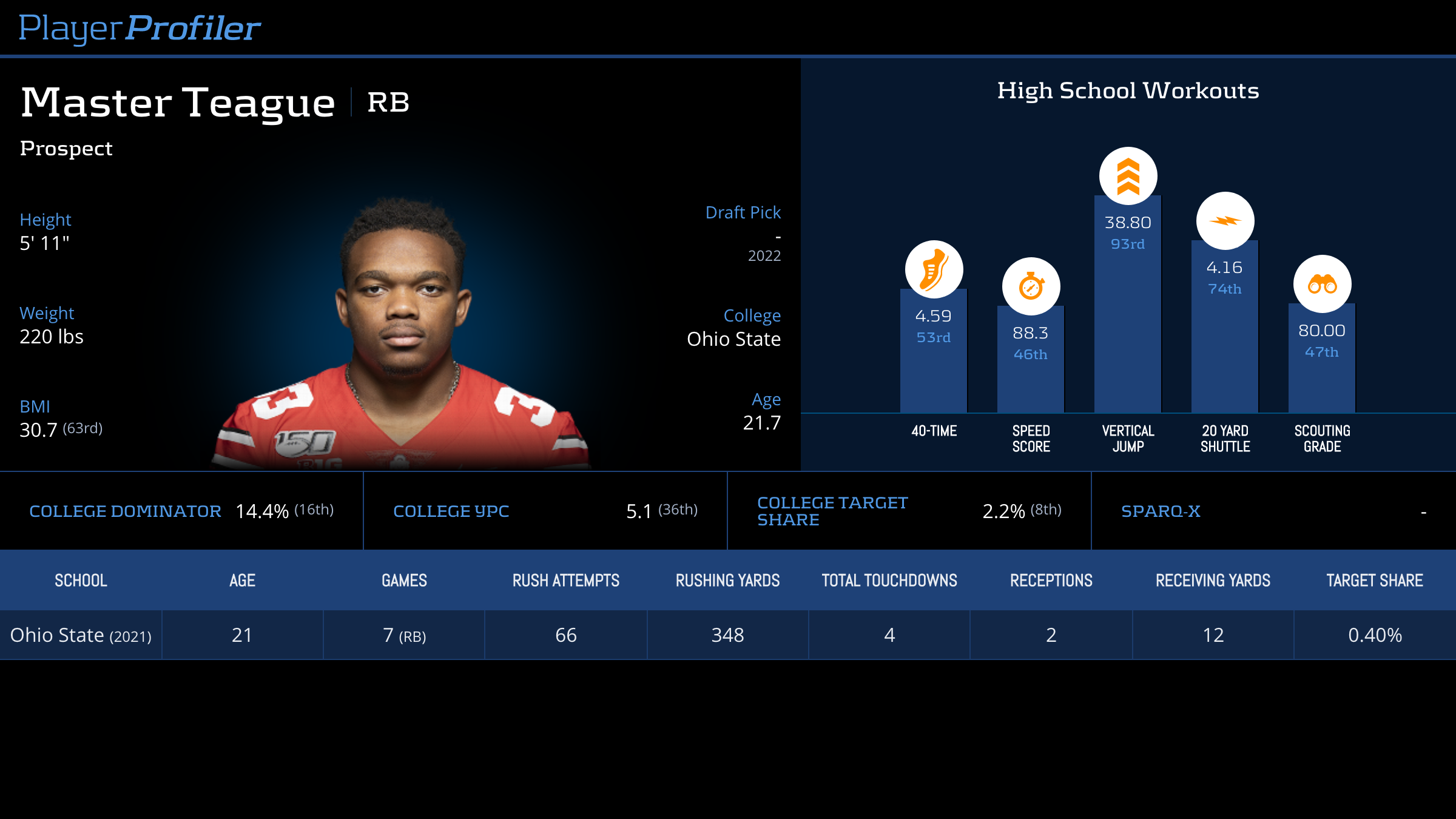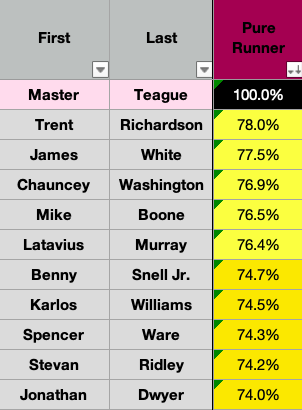This article is part of a series in which I evaluate 2022 rookie running backs solely on their ability to run the ball. The Breakout Finder installments can be found here. The five PlayerProfiler installments can be found here. If you happened to already catch those and don’t need a refresher on my methodology, feel free to skip to the player-focused analysis below.
The Player
Ohio State’s Master Teague is a lot like Georgia’s Zamir White. Both have workhorse size (Teague was listed at 5-11, 225-pounds last year). Neither of them catch a lot of passes (Teague had 11 receptions in 31 career games). And they were both highly-touted high school recruits who had some bad injury luck and never were able to separate themselves from talented teammates at powerhouse programs. In Teague’s case, those teammates averaged a collective 3.84-star rating coming out of high school. This makes them a 90th-percentile group of runners among teammates of backs drafted since 2007.
The Metrics
Relative to those guys, Master Teague did not quite measure up as ball-carrier. His career marks in YPC+ and Chunk Rate+ both land in sub-10th percentile land. He averaged 1.40 fewer yards per carry than other Buckeye backs (3rd percentile). And he ripped off 10-yard runs at a 4.34-percent lower rate than they did (9th-percentile).
Teague ran into defenses packing the line of scrimmage to a greater degree than they were against his backfield mates. The average box count he faced was 0.11 defenders heavier than those faced by other Ohio State runners. That discrepancy is in the 66th-percentile.
Save for nine career carries against 9-man boxes, Teague underperformed the per-carry output of his teammates against every individual box count he faced. The composite Box-Adjusted Efficiency Rating that those performances generate is just an 81.4-percent. It’s the absolute lowest I’ve come across, and one of only three in the class below the 90-percent mark. Jashaun Corbin and Brian Robinson have the other two.
I am ethically obligated to say something nice about a player whose name sounds like it could belong to a Mad Max character. So I will now point out that Master Teague was excellent as an open-field runner. Traditional breakaway run rate metrics would likely tell you a different story. Not surprising because he was so poor on the first level of defenses that he rarely reached the open field. But relative to how often he was reaching the secondary, he converted opportunities into splash plays at a high clip. His career Breakaway Conversion Rate of 39.6-percent is an 86th-percentile mark.
Rushing Efficiency Score and Comps
According to all the non-BAE metrics we’ve covered here (and in addition to overall team quality, rushing volume, opponent strength, and offensive line play), Master Teague earns a 24.7 out of 100 in my running back model’s composite Rushing Efficiency Score. In a composite that I’m workshopping that does account for the box count data, he earns a 36.5. That first number would have Teague pegged as the second-worst pure runner in the class, sandwiched between Isaiah Spiller and Jashaun Corbin. The second would have him fifth from the bottom. Either way you slice it, the numbers aren’t kind.
Reports out of Ohio State suggest Teague can absolutely blaze. Assuming he runs a 4.42 40-yard dash at right around 5-10 and 220-pounds, the following historical prospects are who my running back model identifies as his closest comparable players from a “pure runner” perspective (using the same metrics that go into the Rushing Efficiency composite, in addition to physical measurables):
There simply are not many players with as poor of rushing efficiency numbers who also possess Teague’s purported athleticism. There aren’t many players who weigh 220-plus pounds who possess that athleticism, period. As a result, these comps are not very clean. Even Trent Richardson in the number one spot is just 78-percent similar. And while James White and Mike Boone were comparably poor as rushers in college, they both weigh around 205-pounds and occupy roles that Teague just doesn’t fit into as a pro. He’s a uniquely impressive prospect from a physical standpoint (hypothetically, at least, until he proves it at the Combine), and a uniquely unimpressive one from an efficiency standpoint. Karlos Williams is subjectively my favorite comp for him on this list. But even Williams was better as both a runner and receiver in college.
Last Word
I haven’t seen many people out there hyping up Master Teague, and for good reason. It’s unfortunate that injuries (he tore an Achilles in college and lost his senior year of high school to an ankle injury) robbed us of a guy who could potentially have been a beast. But for the sake of your dynasty teams, there’s no longer much of an argument for taking him seriously as a future fantasy contributor.




